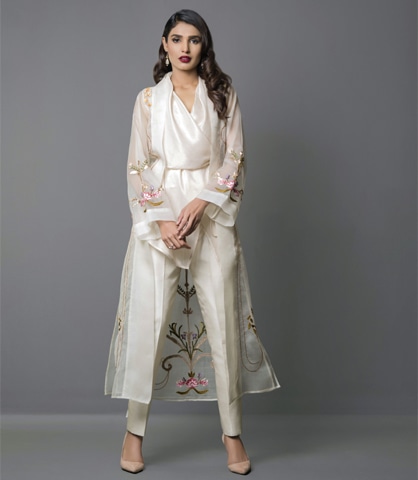Don’t look for fashion on the local high street.
One can easily spot the all-purpose tunic suitable for a day at work. Or the light kurta designed to weather the sweltering summer.
One will also encounter a profusion of digitally printed silk, jewelled brooches glinting on shirt’ front pockets, nets infused with sequins and — let’s not forget — fully embroidered chiffon shirts masquerading as trendy evening wear. But as Karl Lagerfeld once infamously said, “Trendy is the last stage before tacky.” And our money-minting, burgeoning high-street fashion has easily surpassed this last stage and trundled towards commercialised, usually garish design which all looks the same and is more often than not, plagiarised right off the Internet.
Then again, the high street has never been a platform for bonafide high fashion. The world over, fashion trickles down from runways to exclusive boutiques before getting translated to affordable prêt. Fashion house Armani may diversify to slightly lower price points with an Armani Exchange but it will never endeavour to compete with the competitive rates at Zara. In India, Manish Malhotra maintains a Diffusion brand and Ritu Kumar has a Label line. Both brands have vastly different price points from the bespoke bridals that the designers are famous for but, while relatively affordable, the clothes are still far too up-market to qualify as absolute steals.
High street has never been a platform for bonafide high fashion. So what exactly is all the fuss about?
“People are willing to buy expensive designer wear because of the exclusivity that it offers,” observes Nomi Ansari whose forté lies in creating extravagant bridal wear. “There’s also an unfortunate showing-off factor that draws many clients to us. They want to tell people that they are wearing a certain designer’s creation. Tomorrow, should I open up a high-street store where I will be selling tunics for 2,000 rupees a piece, it may manage to make me a household name. At the same time, it will immediately tarnish my reputation as an exclusive designer and consequently, will bring down my profits. Why would I even want to go that way?” Why, indeed? Fashion history is littered with examples of brands that have lost their high-end veneer — and clientele — by becoming too accessible. Pierre Cardin lost out on its snobbery potential when it began extending itself towards lower-priced department-store product lines such as costume jewellery. Likewise, Michael Kors ceased to be aspirational when it chose to open multiple stores across the world and present customers with the option of purchasing from their high-end label, their middle-market brand and a discount-outlet collection. If everyone and anyone can gain access to a label, its image as a luxury item slips away and the high-end customer is no longer interested in paying a premium price for it.
THE NEED FOR INVESTORS

Nevertheless, the high street continues to draw local designers towards it much like the ephemeral pot of gold at the end of a rainbow. One only has to acknowledge the incredible exponential growth of Khaadi to realise how profitable ready-to-wear can be. Khaadi, though, is an exception and cash flow generally doesn’t come too easily. Most ready-to-wear heavyweights — Sapphire, Ideas Pret, Al-Karam, Crescent, Satrangi by Bonanza and Nishat Linen prêt come to mind — are backed by mills or manufacturing units with deep pockets and extensive machinery at their disposal. Clothes can easily be manufactured in-house and all outsourcing is done in mass quantities, thereby reducing production costs.
A designer label, on the other hand, will create readyto-wear in smaller numbers. An effort may be made to abide by particular quality standards and ideally, some semblance of the designer’s high-end aesthetic will be visible in the apparel. Given that the designer is not backed by a heavy-duty investor, the fabric, embroidery, printing and stitching will all cost far more than it does for a mill with access to its own machinery. All this will inevitably hike up the final price.
Fashion history is littered with examples of brands that have lost their high-end veneer — and clientele — by becoming too accessible. Pierre Cardin lost out on its snobbery potential when it began extending itself towards lower-priced department-store product lines such as costume jewellery. Likewise, Michael Kors ceased to be aspirational when it chose to open multiple stores. If everyone and anyone can gain access to a label, its image as a luxury item slips away and the high-end customer is no longer interested in paying a premium price for it.
“I don’t think a designer can step into retailing prêt unless backed by an investor,” says Nomi. “But it’s rare to find an investor who has the same vision as the designer and partnerships tend to collapse. Even if things do work out, the designer has to open retail stores and work with numbers and quantities before eventually bringing in profits.” On the rare occasion that the designer-mill partnership does work out, the result can be game-changing. A case in point is Sapphire with designer Khadijah Shah as Creative Director and the growing Crescent brand with Faraz Manan at its helm. Meanwhile, Maheen Khan is one of the few local designers who has valiantly endeavored to fl y solo in prêt’s clustered market. Her Gulabo is located in a popular mainstream mall and stands out from the pastiche fashion in its vicinity. At Gulabo, the designs are practical yet stylish but are also priced higher given that Maheen runs a small-scale operation. Is she able to break-even? “Barely,” the designer answers honestly. “I am pulling through by the very skin of my teeth. Of course there are women who appreciate the effort and finesse of a designer creation but there are many more who lack fashion sense and simply opt for lower price-points. I refuse to put myself in the same league as the prevalent high-street. I make the effort to tweak the silhouette, the print and the embellishment with each and every outfit.
My customers understand this while it’s sad that others lack the aesthetic to appreciate it.”
THE HIGH-END ROAD

Meanwhile, Deepak Perwani — who owns a store at the same mall as Maheen, as well as at other locations — categorises the ready-to-wear he creates as a ‘mid-brand.’ “I don’t want to become a mass-market label,” he says.
“A woman may buy her daywear from other stores but she will come to my store for clothes that she will treasure over the years.” Across the local sartorial landscape, designers keep their focus on high-end prêt. HSY maintains that his ethos leans towards luxury. Similarly, Sania Maskatiya, Shamaeel Ansari, Nida Azwer Atelier and Misha Lakhani are among the many designers who stay focused on the heavy-duty profits generated from creating bridal and trousseau-wear while extending themselves towards light formals and cotton capsule lines. The latter are designed in limited quantities, catering purely to the affluent who are willing to pay the extra price required to stand apart from the crowd.
Designers Sonya Battla and Sara Shahid operate small-scale retail operations, with Kaju and Sublime respectively, but are yet to expand to more stores.
What primarily limits designers are the prices prevalent on the high-street, usually beginning at 2,000 rupees and teetering up to about 5,000 rupees. “Our production costs are higher than this,” points out Umair Tabani, CEO at Sania Maskatiya. “We can’t compete.” Zaheer Abbas, who only recently opened his stand-alone store near Karachi’s E-Street, adds, “In order to set my brand apart from the competition, I try to innovate with cut and craft. For instance, one of the most popular designs at my store is a simple pencil pant, made from raw silk, priced at 12,000 rupees. Customers may be able to buy basic tunics from here and there but a well-cut pant is hard to find.
They understand this and are willing to pay the price for it.” But while most admit that the local high-street is no easy playing field, designer duo Sana Safinaz have proven to be exceptions to the rule.
THE SANA SAFINAZ SECRET

Throwing caution to the wind, Sana Hashwani and Safinaz Munir chose to launch into mass-market retail some four-odd years ago. The designers had hitherto been renowned for their bridal wear and their yearly lawn collections which infamously sold out to massive crowds. Having gained considerable business and design acumen by retailing mass-centric lawn, the duo chose to apply this know-how to prêt. Fast-forward to the present day, Sana Safinaz continue creating bespoke luxury wear but tend to be better known for their retail. The brand now has 22 high-street stores in different prime locations in the country, although Safinaz admits that it’s still an uphill struggle.
“It is a constant struggle but there can be multiple equations to it,” she explains. “Since most of our manufacturing is outsourced, lowering costs becomes very difficult when competing with other brands that have started off with manufacturing as their mainstay. We make sure that we know the lowest possible break-even point for every individual article and then work the math backwards in order to set a target cost for sourcing and manufacturing. It’s also important to understand design commercialisation.
What is your target market specifically looking for under what value? We have closely monitored product performance and instantly incorporated market feedback to create alignment between our products and the customer. We also determine quantities for every article based on forecasted performance.” Safinaz continues: “We have made a conscious effort to retain the Sana Safinaz signature while letting go of extra-value additions that are not primarily demanded by the market. In other words, our business strategy is majorly design-centric, allowing us to lower the costs of sourcing, printing and assembling the product.” What prompted the designers to enter the grueling world of the high-street when business was already booming for them with lawn and bridal couture? “We feel that globalisation has triggered a longterm death for designer labels across the world,” observes Safinaz. “Highstreet brands are doing much better with well-planned merchandise rotation, allowing them to trade over lower margins, which leads to lower price points. We simply identified this trend early and reacted to it.” It seems that Sana Safinaz have devised a method to the high-street madness. It remains to be seen whether they will be able to last the long haul in an increasingly competitive environment or lose their luxury appeal à la Michael Kors. The remaining majority of Pakistan’s fashion fraternity appears to have found alternate routes to build their businesses.
And so the high-street remains where it is — bolstered by economical pricing and financially sound investors. Does it make one happy to eliminate the no-good tailor and simply buy clothes off the rack? Of course it does. Do we buy often from the high-street stores? Yes, simply because it is convenient and affordable. But are the options available to us exciting, creative or even original? Hardly ever.
It’s a win or lose predicament and one that could perhaps be alleviated should high-street bigwigs occasionally collaborate with designers; something along the lines or Karl Lagerfeld or Balmain for H&M or Victoria Beckham for Target. But can designers and investors forego egos in order to place focus on improving market standards while simultaneously aiming for an ultimate financially beneficial goal? That’s a debate for another day.
Published in Dawn, ICON, July 16th, 2017

















































Dear visitor, the comments section is undergoing an overhaul and will return soon.